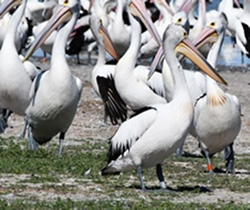 Scientists hope the secret lives of Australian Pelicans will be revealed in more detail following the Department of Planning and Environment (DPE) launching a project to track the travel habits of the majestic birds.
Scientists hope the secret lives of Australian Pelicans will be revealed in more detail following the Department of Planning and Environment (DPE) launching a project to track the travel habits of the majestic birds.
Senior Scientist at DPE, John Porter said more than 1,200 birds across three locations had so far been fitted with brightly coloured leg bands which showed where the pelican hatched.
Dr Porter called on the public to log any sightings of the banded birds to help build a picture of their movements.
“Once pelican chicks fledge, they take to the skies but where they choose to go and nest is critical data we are keen to collect,” Dr Porter said.
“We can use this information to make decisions on wetland and water management for sites favoured by the pelicans and to find out if pelicans prefer to return to where they hatched to breed,” he said.
“Fully grown pelicans have a wingspan of around 2.5 metres which means they can travel considerable distances.
“One adventurous Lake Brewster banded bird has been spotted 650 kilometres away in St George, Queensland.”
Dr Porter said almost 400 birds were banded at Narran Lake in late March and bird watchers should look out for pelicans returning to coastal regions from May.
He said the pelican banding project had been running since 2017, with Narran Lake added for the first time this year.
“To report a banded pelican sighting, email [email protected], including location, band number, condition of the bird, behaviour and a photograph if possible,” Dr Porter said.



